

Dracaena massangeana is part of the dragon plant family.
Dracaena massangeana key facts
Name: D. fragrans ‘massangeana’
Common names: corn stalk plant, mass cane, dragon plant
Family: Agavaceae, indoor plant
Exposure: very well-lit, even full sun
Soil: draining soil mix – Height: 3 to 6 ½ feet (1 to 2 m) – Foliage: evergreen
Its complete scientific name, D. fragrans, hints to its rare scented blooming. Here are tips and advice to care for your Dracaena massangeana, how and when to repot and water it.
→ Related: problems a dracaena plant can get
The Dracaena massangeana plant requires good soil mix that can be amended with ⅓ compost, if you’ve got some.
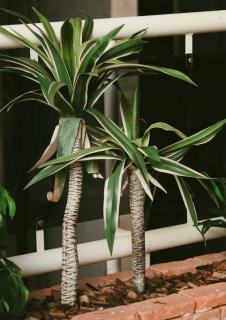 In order to enhance drainage, pour clay pebbles or small stones into the pot to form a layer at the bottom.
In order to enhance drainage, pour clay pebbles or small stones into the pot to form a layer at the bottom.
This will help ensure that roots won’t wallow in water, which could be fatal to it: check out this picture of a Dracaena massangeana with yellow leaves.
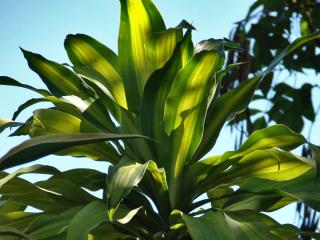 As is customary for plants in pots, feel free to place a bed of gravel, small stones or clay pebbles to drain the water better. Atop this layer, you’ll be using a blend of soil mix, garden soil and sand.
As is customary for plants in pots, feel free to place a bed of gravel, small stones or clay pebbles to drain the water better. Atop this layer, you’ll be using a blend of soil mix, garden soil and sand.
Generally speaking, dracaena is intolerant to the cold and will only grow outside wherever the climate is quite warm with a temperature always higher than 63 to 65°F (17 to 18°C).
Under our climates, Dracaena massangeana adapts well to living indoors in our apartments and homes.
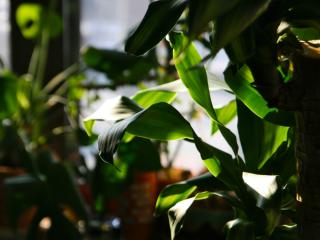 It grows best when surrounding temperatures hold at around 70 to 72°F (20 to 22°C) and requires very good light, even direct sunlight.
It grows best when surrounding temperatures hold at around 70 to 72°F (20 to 22°C) and requires very good light, even direct sunlight.
Choose for it a place near a window facing to the South or West so that it would bathe in a good deal of both indirect light and sunlight – do the opposite if you’re in the Southern Hemisphere.
If you live in a house that is quite dark, avoid purchasing this particular dracaena. It won’t cope well with lack of light.
All year long, mist water on the leaves, preferably soft water.
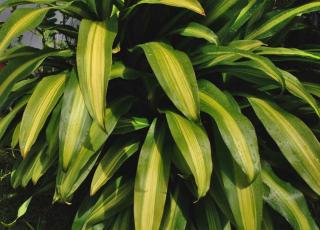 This is usually the time of the year when the dracaena massangeana grows most.
This is usually the time of the year when the dracaena massangeana grows most.
Water regularly while letting the soil mix dry in the surface before watering again.
Watering must be regular but limited, in order to not suffocate the plant’s roots. Every 4 or 5 days is largely sufficient.
More or less every two weeks, you can offer it some liquid fertilizer, taking great care to moisten the soil mix beforehand.
Start reducing the watering because the plant water needs begin to decrease.
Only when the soil is dry down to the first inch or so (a couple centimeters), water to moisten the entire soil mix clump again.
Again, one might say that watering one or 2 times a month should be enough.
But this also depends on where your dracaena is placed: if it is in full sun, its needs will surely be higher.
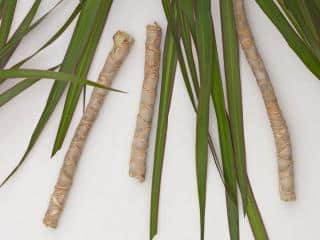 This reproduces very easily by preparing cuttings. This generally means sacrificing one of the stems in order to make new plants.
This reproduces very easily by preparing cuttings. This generally means sacrificing one of the stems in order to make new plants.
What’s nice is that you can make several plants : all you need are portions of stems that are around 6 inches long (15 cm) at least.
Watering is what makes your Massangeana plant vulnerable: don’t overwater and make sure soil drains well.
→ Detailed article: problems a dracaena plant can get
This plants likes growing. It’ll put all its efforts into into its main stem. It’ll only branch out when the main stem is cut. As a result, you might get a plant that’s too tall, easily more than 10 feet in time.
The solution is to behead the plant and to plant the cutting again. You can even plant it right next to the original stem: this will give you different levels of leafage.
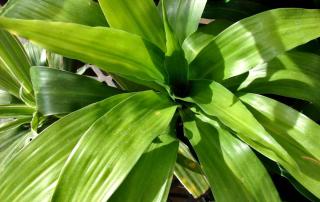 D. fragrans ‘Massangeana’ has variegated leaves. They’re nearly always darker green on the outside and lighter green on the inside.
D. fragrans ‘Massangeana’ has variegated leaves. They’re nearly always darker green on the outside and lighter green on the inside.
Other Dracaena fragrans varieties don’t have this:
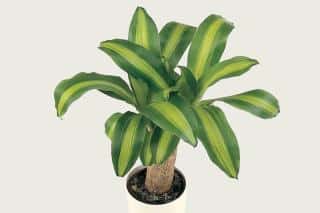 Although some varieties look very similar to palm trees, dracaena massangeana isn’t a palm tree.
Although some varieties look very similar to palm trees, dracaena massangeana isn’t a palm tree.
The similarity is confusing and the care it needs is often very close to that of a palm tree.
All in one aesthetic, resilient and very easy to grow, this is one of the most appreciated and often-purchased indoor plants.
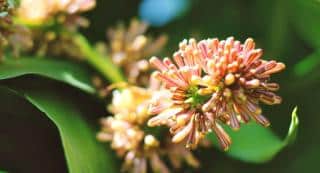 Its foliage is particularly elegant and unique, and its shape and bearing brings a touch of exotic life to a living room, dining area, or any other room of the house that is well-lit.
Its foliage is particularly elegant and unique, and its shape and bearing brings a touch of exotic life to a living room, dining area, or any other room of the house that is well-lit.
Read also:
Did you know that on very rare occasions, sometimes after decades, Dracaena massangeana will flower and release a sensuous, appealing scent?
I’ve been growing one for years and it thrills me to know I can cut it shorter without killing it. It’s nearly taller than the window! Thanks for giving me the courage to hack at it now!
I have one, about six feet tall, potted indoors under a skylight. I have had it about five years and it has consistently been healthy. Recently (and to my shock!) it has bloomed, and looks just like the the Smart Tip above. I don’t really have a question but am stunned by this, especially since the Smart Tip suggests that it is almost a rare occurrence. Anymore information about blooming would be interesting to know. Thanks very much.
My plant was bright & colourful but lately the nice yellow stripe in the middle has also turned green. First lighter green, so you can still see a difference but then they turn all green. Been googling a lot but not one site addresses this. Maybe you can tell me?
Hello! Usually, leaves lose their variegation (different colors like green and white or cream) in the following cases:
– lack of light: if under too much shade, or in a dark room, the plant tries to make up for the low light by producing chlorophyll (the green color of leaves) across the entire leaf, even if some of it was originally variegated.
– leaf grows older: young leaves tend to show a strong, clear color difference, but this slowly changes in time as the leaf ages.
I suspect your draceana massangeana is lacking light, relatively. It still has enough to grow, but not so much that the colors stay marked. Is there a way you can give it more light, either by putting it nearer a window, placing a white or reflective object/mirror behind it, etc? Remember that it doesn’t like the air to be too dry, so as you bring it closer to the window, find ways to also increase air moisture around it.
Hope this helps!
Thank you for your quick reply. Unfortunately I don’t really have a spot where it can get lots of ‘shaded’ light coz of the layout of the space. But I dusted the leaves, that was overdue and will keep an eye on, and I also trimmed it so light reaches the leaves more easily.
It is 4 years old so think that would then also play a role. I want to repot it, give it a fresh start. All together, should make at least a bit of difference.
Thanks again!
Sure thing! Another tip is to spread a light-colored mulch on top of your pot, this will reflect some of the light it gets up where the plant needs it. White gravel, aquarium rock
Amazed by all the wonderful, useful information particularly given my total ineptitude with growing anything very much.
I have just purchased my first dracaena massangeana. Apart from my own ineptitude the question is whether my best friend here in Trieste, Italy will love it and look after it properly when I return to Australia for a few months!? We can but hope…..
Thank you very much for your nice comment, Hugh! I’m happy this information helps. If you’re worried about how it may survive, just have your friend over for a meal and show him or her how you water – and give a calendar with days marked on it to be sure! Note that it’s better to underwater than to overwater, so if a date is missed, just wait for the next one instead of doubling down…
My own personal dracaena favorite is the dracaena bicolor!